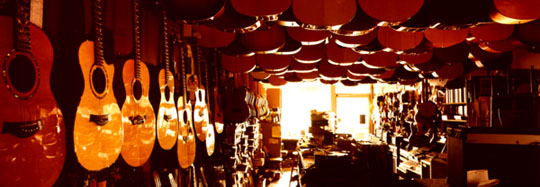

Here are some quick generalizations from my experience. As always, your mileage may vary. I'm concerned because I'm seeing a "rising tide of conformity" in guitar usage, ie, "If you play 'this style', you've got to use a 'this type' guitar. My eyes have been opened recently to some other possibilities. The bottom line is that your mind, heart, ears, and hands must come together to make a choice for you which reflects your own aesthetic sensibilities. The info below is offered to provide a starting point.
TOP WOOD TYPES:
According to many, the top wood and bracing type have the greatest impact of any of the factors upon the sound of a guitar.
For years, spruce has been the norm for steel-stringed guitars. Of spruce types, the less expensive Sitka is typical, and provides a bright, crisp sound. Engelman spruce tends to be brighter but smoother and more "refined" sounding. Spruce tends to be hard to overload and compresses a bit when just before overload point is reached.
Until recently, cedar was only used for classical guitar tops. Some recent steel-string models from several makers have begun featuring cedar as a top wood. Cedar has been found to have a very smooth, mellow, and focused sound for fingerpicking. It exhibits a wide dynamic response up to its overload point, a point which is somewhat lower than that of spruce. It is also extremely responsive to a light touch. Another characteristic of cedar is that it tends to offer excellent individual-string definition.
When used on a guitar top, maple tends to have a strong bottom and bright top but not much middle. Interestingly, all-maple guitars don't generally have a wide dynamic range but do compress nicely when pushed.
More on top wood effects
BODY WOOD TYPES:
Mahogany as a body wood contributes to a relatively mellow and smooth but bright sound. When recorded solo, a mahogany-bodied guitar can be very pleasing because it will generally have less "sproing" than a Rosewood-bodied one. As part of an ensemble, however, mahogany-bodied guitars can sometimes have problems cutting through a mix.
Rosewood has a stronger upper-midrange component than mahogany and cuts through an ensemble nicely. It is also more bold in the bass regions. On the other hand, when recorded solo, it can sometimes end up sounding a bit jangly. Of course some people love that brassy sound!
Hawaiian Koa is a wood type which lately has impressed me. It offers an interesting tonal combination: Bright and clear but not jangly. Koa occupies a niche between Mahogany and Rosewood. I've dicovered that Koa seems to naturally counter-act the "quack" of a piezo transducer to a pretty good degree.
In my experiences, maple as a body wood has a strong bass and treble response but has less midrange. This imparts a thinnish sound to a guitar with crisp highs and full lows which is great for a "chinka, chinka" rhythm sound.
BODY STYLES:
The small "00" styles are favorites for fingerstyle. They are wonderfully balanced for recording but often don't cut it for flatpicking, sing-alongs, or ensemble work.
Grand concert and grand auditorium types are nicely balanced and are a good all-round style. While they lack much of the "boom" of the larger body styles, their sounds are nicely balanced across the strings. They are still capable of some power when recording.
Jumbos and dreads dominate live situations with no sound reinforcement. Their large lower boughts project and provide lots of low-end power. When recording, they can get really boomy really quickly. Used live they can support low-end feedback. By the way, Neil Young did EVERYTHING on a dread for years. You CAN roll-off boominess with EQ and there's simply is no other way to get this low-end.
CONCLUSIONS:
Here are some logical combination of body/top woods and shapes:
Strummed rhythm: For a full, defined sound, go for a rosewood/sitka spruce combination. For a little more refinement, go rosewood/Engelmann spruce. For a more mellow but crisper sound, try mahogany/spruce. For a thinner sound, go with maple/spruce. Body shaped can go from grand auditorium for lighter strumming to jumbo, when you need a full, deep bass.
Flatpicking: The two body wood combinations I see most in flatpicking circles are rosewood/spruce and maple/spruce. Here again, you can substitute Engelmann for sitka to get a more refined sound. Flatpickers tend to prefer dreadnoughts, though I've seen some light players using grand auditoriums.
Fingerstyle:
This area has the most variation. For a softer sound, go with mahogany/cedar. To add clarity on the upper end and better individual-string definition, go with koa/cedar. For a bolder sound with more sustain, go with rosewood/cedar. To brighten any of the above, change the top to Engelmann spruce. In this discipline, "00" bodies, grand concerts, and grand auditoriums prevail, but some love the deep bass of the larger instruments.